Genre: Action Developer: Sega Ent. Publisher: Sega Ent. Players: 1 Released: 1988
Sometimes simplicity is king. The ongoing influx of indie titles confirms that so long as there are games, there’ll always be a market for those which put gameplay first. Even many of today’s story-driven triple-A games, when the smoke and mirrors have been seen through, reveal themselves to be scripted, straightforward affairs. Both types of games can be exhilarating, and serve as proof that not every game needs to have the systems and subsystems of first-person stealthy affairs or stat-heavy RPGs.
While Global Defense immediately and obviously lacks the production values of the sort of games that would hit the market some thirty years later, it follows a similar ethos of simplicity, in its own way. It’s unlikely this was wholly intentional – the Master System port is based on the arcade title Strategic Defense Initiative, and a host of the expected cutbacks were made, yet the game rarely feels like less than what could have been. This is a modest space shooter that, although lacking lasting appeal, never feels like anything less than a complete package.
To say that Global Defense is an imitation of Missile Command would be a fair statement, but one that shouldn’t be overstated. While Sega’s space shooter borrows heavily from Atari’s in terms of attacking – the player’s projectiles do not hit immediately, but they do create a large area of effect – there’s enough going on here, from graphics and perspective to overarching game design, that set it apart from Missile Command or any other shooter of the time. A major design change is that, in the initial, Offensive half of each stage, players control a satellite moving from left to right, vulnerable to enemy attacks and requiring its own navigation to survive the round.
The second half of each round, the Defensive half, plays much more akin to Missile Command, but there are still some notable caveats. Your satellite can still be moved, and since your location affects the time it takes for your missiles to hit, this can be a wise, if rarely crucial element to your strategy. The Defensive round itself goes well with the offensive half – in each, your main objective isn’t simply to stay alive, but to ensure missiles and enemies don’t make it past your line of defense. You can take a total of twenty misses before it’s game over, and the number carries over from Offensive to Defensive. It’s a great way to keep tension and challenge high throughout; a bad Offensive run will have a knock-on effect on the Defensive, seeing you scrambling to ensure the last few missiles don’t make it through.
It works excellently, even with a control scheme that should make for a clunky, unintuitive affair. Because Global Defense involves controlling both a satellite and a crosshair, and because the Master System controller couldn’t have possibly allowed any other solution, players depress Button A when they need to move their satellite. There is no way to move crosshair and satellite at the same time, and this should be a disaster; it’s not. Enemies and projectiles approach in such a way that there’s rarely a genuine need to move and shoot simultaneously, and the limitation actually adds a new layer of depth to the game, further making it an exercise in strategy and micromanagement. The original arcade release used a trackball, but the control scheme is set up so well in the Master System port that it’s hard to imagine playing it any other way.
Graphically, Global Defense is something of a tour de force. Perhaps owing to the overall simplicity of the game, there are some breathtaking vistas in the Offensive stage of most levels, in which the space shooter aesthetic is nailed without feeling derivative, and where no pixel of the backdrop feels like a copy-and-paste job. The Defensive half offers a static but no less impressive backdrop of a planet or space station, although some are less appealing than others. Sprites, meanwhile, fare a little worse. Detail is high, the animations are great and there are some terrific little touches, such as the tips of missiles glowing red as they enter the atmosphere in a Defensive round, but the actual design, from a rather unassuming player satellite to enemies ranging from generic to unintelligible to almost rather cutesy, clash with the overall feel of the game.
Audio is similarly hit-or-miss. Some will find the game’s sole theme suitably spacey and listenable for the duration of play, others will find it quickly bland and repetitive. The tune for a perfect round is appropriately bombastic, the game over theme is disjointed and prolonged, bizarrely clocking in at almost a minute, and the few sound effects, such as the destruction of your own or enemy satellites, are functional and nothing more. Global Defense is a game best played with the sound on, but only just.
The appeal, both immediate and lasting, of this arcade-to-8-bit space shooter lies in its ability to hook the player from the start. Taken altogether, it’s a modest game, something of a footnote of the Master System library and of gaming history in general. It’s not a must buy, but if a copy is owned – and it is worth hunting down a copy as opposed to just emulating – it’s a game that can consistently while away an hour or two. Movement, attack, enemy waves and pacing are all finely tuned, and where it lacks in audio and areas of visual design, the core gameplay in Global Defense is enough to deliver a rewarding experience, and capture that coveted “just one more go” urge. Some games weren’t made to set the world on fire, but what Global Defense aims to do gracefully hits its target.
Score: 7 out of 10

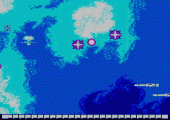
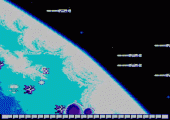
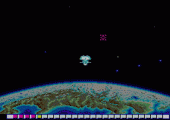
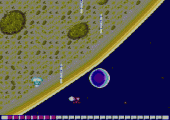
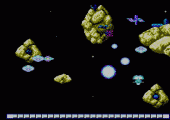
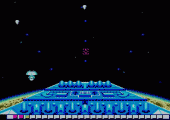
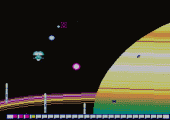
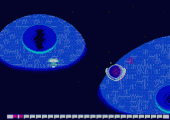
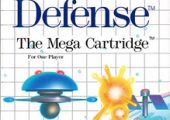
I just wanted to mention, there is an alternate “twin stick” control scheme for Global Defense. It’s described in the manual as a two-player option, with one player controlling the satellite and a second player controlling the Firing Cursor. But it works well as a single-player control scheme. Here’s how you set it up (and I’ll add my recommendations for contemporary players).
Plug in two controllers. To start, on Control Pad 2, press Right and Button 2 or press Left and Button 1. Control Pad 1 will move the Firing Cursor, Control Pad 2 will move the satellite, and firing will be automatic.
My recommendation is to the physically re-arrange your controllers so you move the satellite with your left hand and aim with your right hand, as is typical in contemporary FPS and twin-stick games. I also recommend using a joystick to move the satellite and using the Sega Sports Pad in digital mode to move the Firing Cursor, which will provide pixel-perfect accuracy in aiming. Have fun!